

Asiaq. In Inuit mythology, Asiaq is a weather goddess (or, more rarely a god) and was quite frequently invoked by the angakoq for good weather, for instance if spring was late it was important content her to make sure she would send rain and melt the ice.

In Inuit mythology of Greenland, Asiaq, the mother of weather decides the quantity and the time for snow to fall. Barüske, Heinz (1969). "Asiaq, die Herrscherin über Wind und Wetter". Eskimo Märchen. Die Märchen der Weltliteratur (in German). Baal. Bronze figurine of a Baal, ca. 14th–12th century BC, found at Ras Shamra (ancient Ugarit) near the Phoenician coast.

Musée du Louvre. "Baal" may refer to any god and even to human officials. In some texts it is used for Hadad, a god of thunderstorms, fertility and agriculture, and the lord of Heaven. Since only priests were allowed to utter his divine name, Hadad, Ba‛al was commonly used. Nevertheless, few if any biblical uses of "Baal" refer to Hadad, the lord over the assembly of gods on the holy mount of Heaven; most refer to a variety of local spirit-deities worshiped as cult images, each called baal and regarded in the Hebrew Bible in that context as a false god.
Etymology[edit] Chaac. Earthenware effigy urn (an incense burner) of Chaac, 12th-14th century Chaac (also spelled Chac or, in Classic Mayan, Chaahk [t͡ʃaːhk]) is the name of the Maya rain deity.
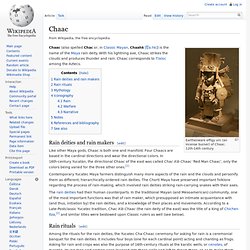
With his lightning axe, Chaac strikes the clouds and produces thunder and rain. Chaac corresponds to Tlaloc among the Aztecs. Cocijo. Cocijo[pronunciation?]
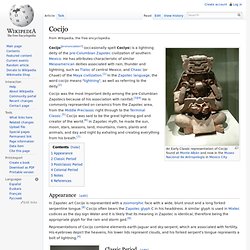
(occasionally spelt Cociyo) is a lightning deity of the pre-Columbian Zapotec civilization of southern Mexico. Dzahui. Dzahui, Mixtec god of rain.
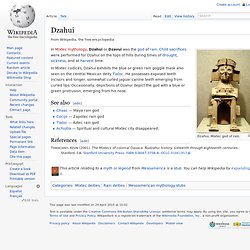
In Mixtec mythology, Dzahui or Dzavui was the god of rain. Child sacrifices were performed for Dzahui on the tops of hills during times of drought, sickness, and at harvest time. In Mixtec codices, Dzahui exhibits the blue or green rain goggle mask also seen on the central Mexican deity Tlaloc. He possesses exposed teeth incisors and longer, somewhat curled jaguar canine teeth emerging from curled lips. Indra. Origins[edit] Aspects of Indra as a deity are cognate to other Indo-European gods; they are either thunder gods such as Thor, Perun, and Zeus, or gods of intoxicating drinks such as Dionysus.

The name of Indra (Indara) is also mentioned among the gods of the Mitanni, a Hurrian-speaking people who ruled northern Syria from ca.1500BC-1300BC.[5] Vedic Indra corresponds to Verethragna of the Zoroastrian Avesta as the noun verethragna- corresponds to Vedic vrtrahan-, which is predominantly an epithet of Indra. The word vrtra-/verethra- means "obstacle". Lono. In Hawaiian mythology, the deity Lono is associated with fertility, agriculture, rainfall, music and also peace.

In one of the many Hawaiian legends of Lono, he is a fertility and music god who descended to Earth on a rainbow to marry Laka. In agricultural and planting traditions, Lono was identified with rain and food plants. He was one of the four gods (with Kū, Kāne, and Kāne's twin brother Kanaloa)[1] who existed before the world was created. Lono was also the god of peace. In his honor, the great annual festival of the Makahiki was held. Hawaiian Sweet Potato God, possibly a depiction of Lono. Lono and Captain Cook[edit] Some Hawaiians have believed that Captain James Cook was Lono returned and indeed this fact may have ultimately contributed to Cook's death (see James Cook - Third voyage (1776-1779)).
Hunter S. The late Gonzo writer Hunter S. Thompson's writings on the experience have been compiled into a book, The Curse of Lono, illustrated by Ralph Steadman. See also[edit] Tlaloc. Tlaloc (Classical Nahuatl: Tlālōc [ˈtɬaːloːk]) [1] was an important deity in Aztec religion; a god of rain, fertility, and water.
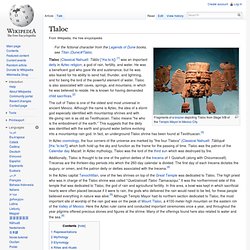
He was a beneficent god who gave life and sustenance, but he was also feared for his ability to send hail, thunder, and lightning, and for being the lord of the powerful element of water. Tlaloc is also associated with caves, springs, and mountains, in which he was believed to reside. He is known for having demanded child sacrifices.[2] The cult of Tlaloc is one of the oldest and most universal in ancient Mexico. Although the name is Aztec, the idea of a storm god especially identified with mountaintop shrines and with life-giving rain is as old as Teotihuacan. Tó Neinilii. Tó Neinilii[1] (sometimes misspelled as Tonenili) is the rain god of the Navajo people of Arizona and New Mexico.
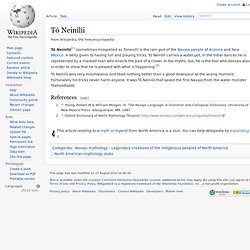
A deity given to having fun and playing tricks, Tó Neinilii carries a water pot. In the tribal dances he is represented by a masked man who enacts the part of a clown. In the myths, too, he is the fool who dances about in order to show that he is pleased with what is happening.[2] Tó Neinilii was very mischievous and liked nothing better than a good downpour at the wrong moment. Fortunately his tricks never harm anyone. Yu Shi. Yu Shi (traditional Chinese: 雨師; simplified Chinese: 雨师; pinyin: Yǔ Shī; literally: "Master of Rain") is a Chinese spirit or god of rain, also known as or conflated with Red Pine (Chisong, 赤松, or, Chisongzi -- Master Red Pine), among other names.

Translations of Yu Shi into English include "Lord of Rain" and "Leader of Rain". As Yu Shi[edit] Yu Shi in popular religion in China and Chinese mythology generally appears in association with Feng Bo, the god of the wind.[1] There are both current religious activities and historical mythical stories associated with Yu Shi. Various references in poetry and popular culture also exist, for example in the Chu ci poem "Yuan You". As Chisongzi[edit]